
Modi’in was nothing but a hick town in the second century B.C., about 20 miles northwest of Jerusalem. But it was the ancestral home of the Maccabee family who led the successful revolt against the Seleucid tyrant Antiochus IV Epiphanes after he desecrated the Jerusalem Temple and forbade circumcision and Sabbath observance. Mattathias, the family patriarch, and his five sons have earned an indelible chapter in Jewish history, still remembered annually in the festival of Hanukkah.
The Maccabean forces were led by Mattathias’s eldest son, Judas, known as the Hammer because of his military prowess. When he was killed, he was succeeded by his brother Jonathan, who assumed the office of high priest as well as the political leadership, but he was soon captured and murdered. Jonathan was succeeded by his brother Simon, who likewise assumed the office of high priest, although the Maccabees were not of a high priestly family. Oddly enough, both Jonathan and Simon succumbed to the very Hellenistic culture that their father had rebelled against.
Modi’in could boast not only that it was the ancestral home to the Maccabees, but also that it had a famous monument. Simon had brought the bones of his brothers Jonathan and Judas back to Modi’in to bury them near their father, Mattathias. Then, over this tomb, he built a high monument so that it could be seen from a great distance. The monument was made of polished stone and included seven pyramids—two for his mother and father and five for him and his brothers. Each of the pyramids was supported with great columns and had an elaborate setting, including suits of armor and carved ships. This is all described in the Book of Maccabees (1 Maccabees 13:25–30). Probably composed in the first century B.C., the text adds that this monument “remains to this day.”
The first-century A.D. Jewish historian Josephus apparently copied this account in his Antiquities of the Jews. There he notes that Simon built “a very large monument” of “polished white stone” that soared “to a great height.” It could be seen “for a long way off” and was “wonderful to see.”1
The Maccabean tomb at Modi’in marked a distinctive departure in Jewish tomb architecture. Until then, Jewish tombs had not featured outward display. Even distinguished Jews were buried in caves with little outdoor grandeur. The Modi’in tomb of the Maccabees, however, ushered in a short period of so-called “display tombs.” Simon transformed a private family tomb—the pre-existing tomb of Mattathias and his sons Judah and Jonathan—into a flamboyant, public monument. The Maccabean tomb in Modi’in made a new kind of statement.
Many of the Jewish display tombs that ensued have survived, and they never fail to impress visitors to Jerusalem. The earliest of these is Jason’s Tomb in the fashionable Jerusalem neighborhood of Rechavia, which must have been outside the city when the tomb was built in the late second century or early first century B.C. The most dramatic of the Judean display tombs are in the Kidron Valley: Absalom’s Tomb (which of course it is not), the family tomb of Bene Hezir and the Tomb of Zechariah. On the other side of town, north of the Old City, is the elaborate tomb known as the Tomb of the Kings, which, in fact, is the tomb of the famous convert to Judaism, Queen Helena of Adiabne. Finally, less well known is a tomb in Silwan (a village in part of Jerusalem) known as the Tomb of Pharaoh’s Daughter, so named because it originally was topped by a large pyramid that was later destroyed.
In short, the Maccabean tomb in Modi’in started a trend of lavish display tombs, largely in Jerusalem, reflecting the wealth, power and prominence of the family whose deceased members lay inside. Perhaps that is what the Gospel writer had in mind when he inveighed: “Woe to you, scribes and Pharisees! For you are like the whitewashed tombs that on the outside appear beautiful, but inside they are of dead men’s bones” (Matthew 23:27).
If all this began with the Maccabean tomb in Modi’in so tantalizingly described in the Book of Maccabees and Josephus, one is naturally led to ask what it looked like in more detail. Unfortunately, all we have are these literary texts. A few years ago a claim was made that some tomb remains discovered in Modi’in might be related to the Maccabees, but the conjecture soon evaporated, and the Israel Antiquities Authority issued a formal correction.
With so little to go on, we must next ask what inspired Simon the Maccabee to import this kind of display tomb into Judea. The answer to that question is pretty clear. That, in turn, may give us a better idea of what the Modi’in tomb looked like.
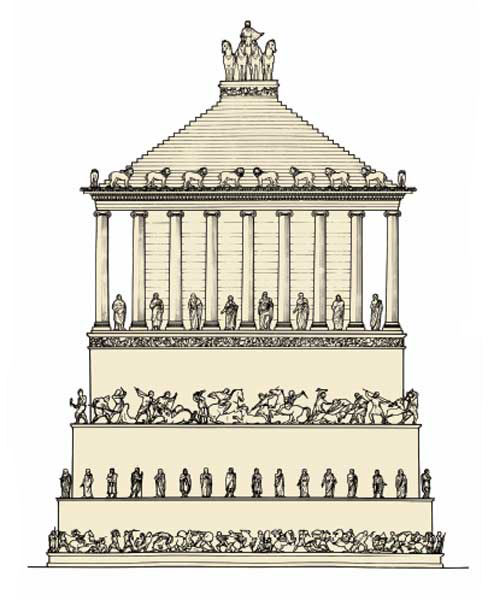
There was a famous tomb in the ancient world—indeed, so famous it was considered one of the Seven Wonders of the World—that almost surely provided the model for the Maccabean tomb in Modi’in. It was not only renowned, but many of its features were duplicated in the description of the Maccabean tomb in the Book of Maccabees and in Josephus. It is the funerary monument of the Carian king Maussollos built in the fourth century B.C. This tomb was well known throughout the ancient world and doubtless inspired other funerary monuments in addition to the one at Modi’in.2 Indeed, the word “mausoleum” for any large, built tomb is derived from Maussollos, the ruler whom this famous funerary monument memorialized.
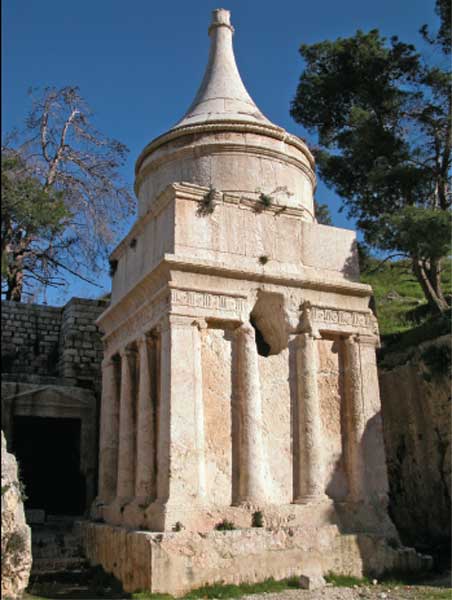
The tomb of Maussollos is described in some detail by the Roman historian Pliny the Elder, writing in the first century A.D.:
This tomb [was] built … for Maussollos, king of Caria … [and is] one of the seven wonders of the world. It is 63 feet long on the south and north sides, shorter on the façades. Its total circumference is 440 feet. It rises to a height of 25 cubits and is surrounded by 36 columns. They called the circumference a “colonnade” … Above the colonnade [is] a pyramid equal to the lower part [the podium] contracting by 24 steps to the topmost point. On the summit is a marble four-horse chariot … When this is included [in the building’s height] it brings the whole building to a height of 140 feet.3
It was not only the architecture and size of the structure, but the lavish sculpture with which it was decorated that gave the building its repute. Pliny names four distinguished Greek sculptors (Skopas, Leochares, Timotheos and Bryaxis), each of whom was responsible for the decorations on one side. The well-known Roman architect Vitruvius says that the sculptures on one side of the monument were the work of the most famous Greek sculptor of all time, Praxiteles, who also carved the first undraped cult statue of Aphrodite at Knidos; however, modern scholars doubt that Praxiteles executed any of the sculptures on Maussollos’s tomb.4
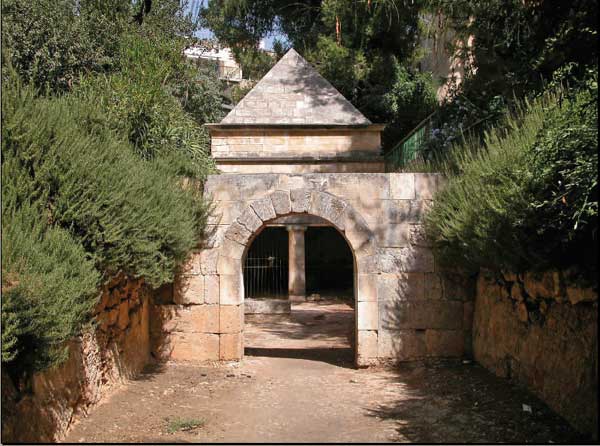
We know considerably more than Pliny tells us about the original Mausoleum—especially its sculptures—from the archaeological saga of the tomb, which reads almost like an unfolding mystery novel.
Maussollos ruled the Persian province of Caria as the Persian satrap, or governor, from 377 to 353 B.C., with his capital at the ancient port of Halicarnassus (modern Bodrum) on the southwestern coast of modern Turkey.
The Mausoleum stood reasonably intact until an earthquake in the 13th century caused the upper part and the colonnade to collapse. In the late 15th century, when the Knights of St. John of Malta (Hospitallers) decided to refortify their imposing castle on the height above the harbor, they turned to the Mausoleum for easily accessible stone. The Bodrum castle was both the cause of the destruction of the Mausoleum and the means of preservation of some of the key elements. The knights used the blocks of green volcanic stone that had formed the core of the Mausoleum for their own construction. The marble facing blocks and sculptures—horribile dictu—were mostly broken up into small pieces and burnt to make lime mortar. A remarkable account of the destruction of the lower part of the Mausoleum was published in 1522 by a French traveler and poet named Claude Guichard:
The Knights Hospitaller, on acquiring Bodrum, began to fortify the castle. And looking around for stone to make lime, and not finding any more suitable or more accessible than certain steps of white marble, raised in the form of a platform, in the middle of a field near the harbor where once the ancient forum had been, they knocked them down and took them away for this purpose …
After four or five days, having laid bare a large area, one afternoon they saw an opening like the entrance into a cave. Taking candles, they went down into it [the tomb] and found there a large square chamber surrounded by marble columns with their bases, capitals, architraves, friezes and cornices carved in relief. The space between the columns was lined with slabs and bands of marbles of different colors, ornamented with moldings and sculptures that matched the rest of the work, and inserted in the white ground of the wall, where histories and battle scenes were also represented in relief. Having admired this at first, and entertained their fancy with the singularity of the work, finally they pulled it down, broke it apart and smashed it, in order to use it for the same purpose as the rest.

Although the Hospitallers very extensively damaged the Mausoleum, they did not destroy quite all of the sculptured stones they found. Between 1505 and 1507 about a dozen slabs of the frieze showing the battle between Greeks and Amazons caught the eye of one the Hospitaller commanders, who then built them into the walls of the castle for decoration—and in this way they were preserved. In addition, a block from a second frieze with the battle of Lapiths (a Greek clan) and Centaurs (human-headed horses) was mounted in a Crusader wall. Finally, similarly built into the castle walls were the foreparts of four lion statues and a lunging leopard from a hunting group.
Travelers in the 18th and 19th century observed these sculptures in the castle and guessed that they came from the Mausoleum. In 1846 the British ambassador in Istanbul managed to obtain permission to remove some relief slabs and bring them back to London, where they were deposited in the British Museum. They may still be seen there (together with later-recovered sculptures and reliefs).
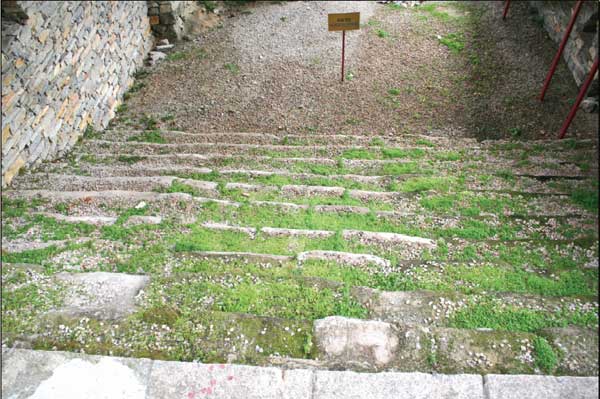
The exhibit of these fragments in London led to an expedition 10 years later to locate and excavate the site of the Mausoleum in the hope of finding more treasures like those in the Crusader castle. The expedition was led by Charles T. Newton, an assistant keeper at the British Museum, with a team from the Royal Engineers.
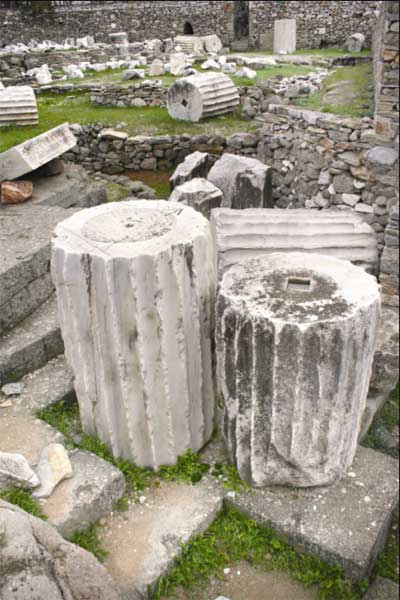
With the help of Vitruvius’s description and a certain amount of trial and error, Newton managed to locate the site of the Mausoleum. He purchased, not without some difficulty, the Turkish houses that then occupied the ground and, on New Year’s Day in 1857, proceeded to dig. His enthusiasm soon turned to disappointment as he discovered the extent of the Hospitallers’ devastation and realized that the Mausoleum had been almost entirely robbed. All that was left was the outline of the rectangular foundation area cut in the soft rock, with a few of the green stone blocks from the core still in position. He called the whole area the Quadrangle.
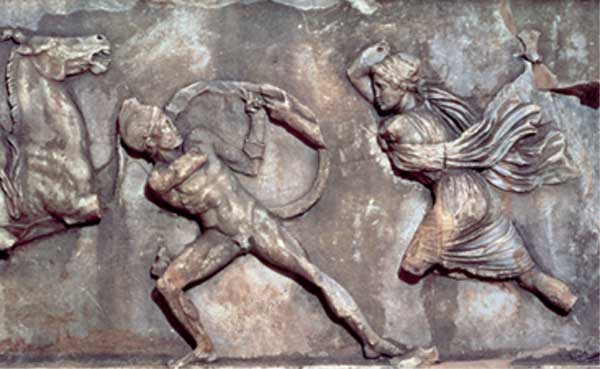
After spending three months carefully extracting hundreds of battered fragments from the ruins of the foundations, he turned his attention to the ground north of the building—and immediately had better luck. Near the northwest corner of the building he came upon a well-preserved Ionic capital, together with an upper column drum. It is, in fact, a corner capital, almost certainly from the corner junction of the north and west colonnades of the Mausoleum. This was the first indication that the architectural order employed on the Mausoleum was Ionic.

But it was the spectacular finds in the eastern half of the north side, in the field of a house belonging to the local imam, that were to change Newton’s excavations almost overnight from comparative failure to spectacular success.
Because the precinct wall of the Mausoleum at this point runs very close to the Mausoleum itself, and, in addition, the hill begins to rise here, the soil cover was deeper at this point than elsewhere. This meant that the sculptures and stones that fell at this point were spared the ravages of the Hospitallers. So it was that Newton came upon the only major undisturbed deposit of sculptures and architectural stones from the Mausoleum.
Included in the remains were steps from the pyramidal roof and fragments of architrave beams that once linked the columns. Also from this area came almost all of the large sculptures on display today in the British Museum, including a horse from the chariot group on the summit and the larger-than-life-sized statues of a man and woman of the ruling dynasty, often identified as Maussollos and his wife Artemisia, although there is no proof of this. Altogether 66 statues or fragments of statues were found in this one deposit, all over life-size.
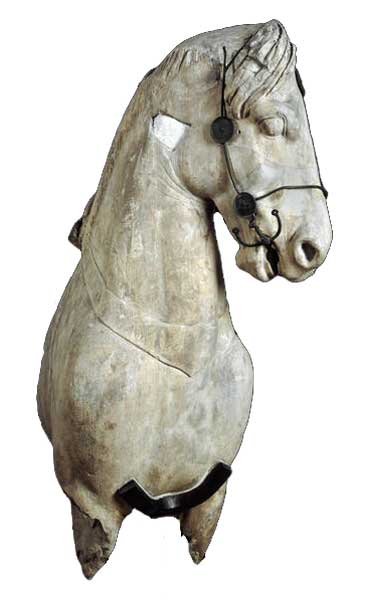
Newton brought back to England not only the sculptures, but also as many of the architectural stones as he could manage, which are now laid out in rows in a British Museum storeroom. They contain vital evidence for a reconstruction of the building. Among these stones are steps from the pyramid roof, including an almost-complete corner step, which proves that the treads of the steps on the longer and shorter sides of the building were of different widths. With the aid of these dimensions, combined with the numbers of pyramid steps (24) and columns (36) given by Pliny, Newton and his architect, Richard Pullan, managed to produce a reasonable reconstruction of the roof and upper part of the Mausoleum.
One of their difficulties, however, was the lack of an accurate and detailed plan of the foundation-cutting, and therefore of the lower dimensions of the building. Because Newton used the cut-and-fill method of the Royal Engineers who were employed in the excavation, the whole of the Quadrangle had never been laid bare at any one time.
This serious deficiency was not remedied until a new excavation was carried out by Professor Kristian Jeppesen of Aarhus University in Denmark between 1966 and 1977. The greatest achievements of his excavation were the clearing and accurate planning of the foundation-cutting and the retrieval of architectural and sculptural fragments left within it.
Some of the most important architectural features of the foundations revealed by Jeppesen’s excavation are the green volcanic blocks like those from the castle, still in place in the southwest and northeast corners. These show that the foundations for the podium of the Mausoleum almost completely filled the cutting. They also provide maximum dimensions for the base of the building of 124 modern feet for the longer sides and 104 feet for the shorter. This is in reasonable agreement with Pliny’s figure for the circumference of the building of 440 ancient feet; if the Greek foot length employed was 13 inches, it is possible.
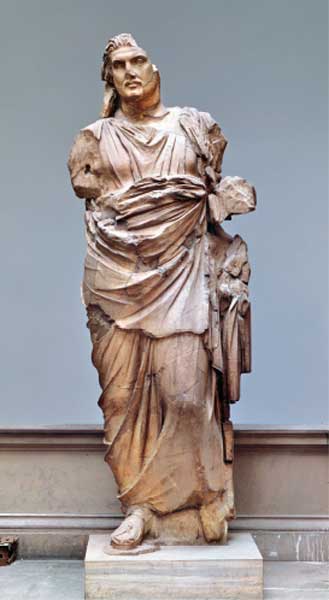
Jeppesen was also able to calculate the space between the columns. If we suppose with Pliny that there were 36 columns, and that they were arranged 11 by 9, this would give maximum dimensions for the top of the podium of 104 modern feet on the longer sides and 84 feet on the shorter, indicating the amount by which the podium was stepped inwards—10 feet on each side. A stepped podium is in agreement with the remark in the 16th-century French report on the work of the Hospitallers that the deeper the knights dug, “the more the structure was enlarged at its base.”
From all of this, a fairly reliable reconstruction of the Mausoleum can be drawn. We have not discussed the evidence for the placement of the statuary because our concern here is for the architecture of the monument as it might illuminate the architecture of the Maccabean tomb at Modi’in. That monument, although architecturally inspired by the Mausoleum at Halicarnassus, was almost surely devoid of figural sculptures and reliefs. For all its Hellenization, Judea remained almost completely without figural representation of any kind during this period.
Architecturally, however, the Mausoleum at Halicarnassus gives us the best idea of the kind of structure built for the heroes of Hanukkah.
But the Mausoleum also has its own message—the everlasting glory of Maussollos. The last word on this subject goes to the Greek satirist Lucian, writing in the second century A.D. In his Dialogues of the Dead, he stages an imaginary confrontation in the underworld between Diogenes, the Cynic philosopher, and Maussollos:
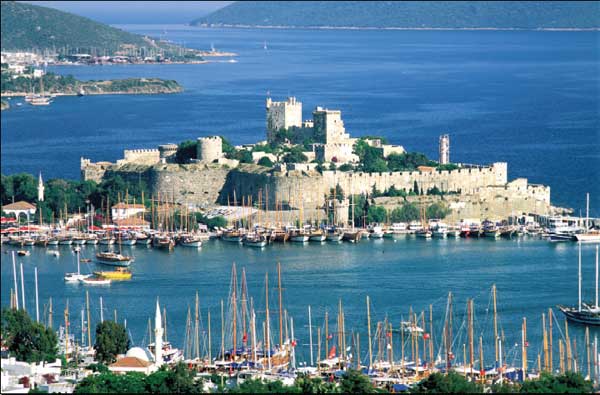
“Tell me Carian,” says Diogenes, “why are you so proud and why do you expect to be honored more than the rest of us?”
“Because,” replies Maussollos, “I was handsome and tall and victorious in war. But most of all because I have lying over me in Halicarnassus a gigantic monument such as no other dead person has, adorned in the finest way with statues of horses and men carved most realistically from the best quality marble.”
Diogenes answers: “My handsome Maussollos, your strength and beauty are no longer with you here. If we were to have a beauty contest, I can’t see why your skull should be thought better than mine. And as for your tomb and that expensive marble, it may give the people of Halicarnassus something to show off and boast about to tourists, but I can’t see what benefit you get from it, unless you’re claiming that you have a heavier burden to bear than the rest of us, being weighted down by so much stone.”
“Is all this nothing then?” exclaims Maussollos. “Are Maussollos and Diogenes equal?”
“No your highness,” replies Diogenes, “we are not equal. Maussollos will groan when he remembers things on earth which he thought brought him happiness, while Diogenes will laugh at him. Maussollos will talk of the tomb built for him at Halicarnassus by his wife Artemisia, while Diogenes does not even know if his body has a tomb. Nor does he care. He has left to future generations an account that he has lived the life of a good man, an account that is loftier than your memorial, most servile of Carians, and built on surer foundations.”
MLA Citation
Endnotes
Among the inspirations from the original Mausoleum is the third-century B.C. (280–246) Belevi Monument near Ephesus on the coast of Asia Minor north of Halicarnassus. It was likely begun for King Lysimachus (died 280 B.C.) but was used instead for the Seleucid ruler Antiochus II (died 246 B.C.). It consisted of a rock-cut socle 33 feet high, an upper story encircled by columns and a pyramidal roof. See Andrea M. Berlin, “Power and Its Afterlife: Tombs in Hellenistic Palestine,” Near Eastern Archaeology, vol. 62, June 2002, p. 145. See in general, J. Fedak, Monumental Tombs of the Hellenistic Age (Toronto, 1990).

